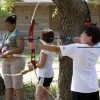 As a 4-H volunteer, one of your most important roles is helping youth learn. Especially because membership in 4-H is voluntary, learning in 4-H must be fun. Even if you’re not a teacher by profession, you can successfully guide youth to learn communication, leadership, citizenship, and other life skills, as well as subject matter through their 4-H projects and club participation. This 5-page fact sheet was written by Keith G. Diem and Judy Levings, and published by the UF Department of 4-H Youth Development, July 2014.
As a 4-H volunteer, one of your most important roles is helping youth learn. Especially because membership in 4-H is voluntary, learning in 4-H must be fun. Even if you’re not a teacher by profession, you can successfully guide youth to learn communication, leadership, citizenship, and other life skills, as well as subject matter through their 4-H projects and club participation. This 5-page fact sheet was written by Keith G. Diem and Judy Levings, and published by the UF Department of 4-H Youth Development, July 2014.
http://edis.ifas.ufl.edu/4h340
Category: 4-H Youth Development
Planning a Successful Field Trip
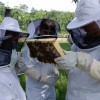 Field trips can be great experiences for youth to learn project content and life skills. Field trips also contribute to the experiential learning philosophy of 4-H. This document includes some suggestions to make a field trip fun, safe, and educational. This 3-page fact sheet was written by Keith G. Diem and Ben Knowles, and published by the UF Department of 4-H Youth Development, July 2014.
Field trips can be great experiences for youth to learn project content and life skills. Field trips also contribute to the experiential learning philosophy of 4-H. This document includes some suggestions to make a field trip fun, safe, and educational. This 3-page fact sheet was written by Keith G. Diem and Ben Knowles, and published by the UF Department of 4-H Youth Development, July 2014.
http://edis.ifas.ufl.edu/4h339
Adopting 4-H Club Bylaws
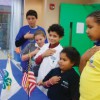 Why does a 4-H club (for youth ages 8–18) need bylaws? For the same reason our country needs a constitution! By having fair and written rules, the rights of all members can be protected. The following is a suggested format for 4-H bylaws. The bylaws below may be adapted to meet local conditions. Be sure to send a copy of your club’s approved bylaws to your county 4-H office. Include in the bylaws the date when they were approved and most recently revised.This 3-page fact sheet was written by Keith G. Diem, Judy Levings, and Ben Knowles, and published by the UF Department of 4-H Youth Development, July 2014.
Why does a 4-H club (for youth ages 8–18) need bylaws? For the same reason our country needs a constitution! By having fair and written rules, the rights of all members can be protected. The following is a suggested format for 4-H bylaws. The bylaws below may be adapted to meet local conditions. Be sure to send a copy of your club’s approved bylaws to your county 4-H office. Include in the bylaws the date when they were approved and most recently revised.This 3-page fact sheet was written by Keith G. Diem, Judy Levings, and Ben Knowles, and published by the UF Department of 4-H Youth Development, July 2014.
http://edis.ifas.ufl.edu/4h338
The ABCs of 4-H: A Primer for 4-H Volunteers
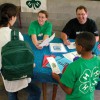 This information sheet is the introduction to the 4-H Volunteer Training Series (VTS). The series contains a wealth of information, from how to start a club, to planning field trips, to how to work with youth. This 5-page fact sheet was written by Keith G. Diem and Ben Knowles, and published by the UF Department of 4-H Youth Development, July 2014.
This information sheet is the introduction to the 4-H Volunteer Training Series (VTS). The series contains a wealth of information, from how to start a club, to planning field trips, to how to work with youth. This 5-page fact sheet was written by Keith G. Diem and Ben Knowles, and published by the UF Department of 4-H Youth Development, July 2014.
http://edis.ifas.ufl.edu/4h335
Selecting a Name for Your 4-H Club
 Each 4-H club is a unique group of individuals who work together toward common goals. A club name should reflect the purpose(s) of the club, often relating to the project(s) the club participates in, or the geographic area where members live or the club meets. One of the first ways to develop a sense of belonging and youth engagement is allowing all of the members to participate in selecting a name for the club. Information in this sheet may help you guide the members in making a wise name choice. This 2-page fact sheet was written by Keith G. Diem, Marilyn N. Norman, Joy C. Jordan, and Lindsey McConnell, and published by the UF Department of 4-H Youth Development, July 2014.
Each 4-H club is a unique group of individuals who work together toward common goals. A club name should reflect the purpose(s) of the club, often relating to the project(s) the club participates in, or the geographic area where members live or the club meets. One of the first ways to develop a sense of belonging and youth engagement is allowing all of the members to participate in selecting a name for the club. Information in this sheet may help you guide the members in making a wise name choice. This 2-page fact sheet was written by Keith G. Diem, Marilyn N. Norman, Joy C. Jordan, and Lindsey McConnell, and published by the UF Department of 4-H Youth Development, July 2014.
http://edis.ifas.ufl.edu/4h337
How to Start a Club (for Youth Ages 8–18)
 Being in a 4-H club provides important opportunities for youth to learn subject matter and life skills while working with a caring adult and other youth. Once youth are 4-H members, they become eligible for a variety of the benefits of belonging to 4-H, including awards, trips, and special events. Of course, it’s meant to be fun for the kids and the leaders too! Starting a 4-H club isn’t difficult, and you are encouraged to seek help from parents or other volunteers. Local Extension/4-H staff can help you get started. This 4-page fact sheet was written by Keith G. Diem, Joy Jordan, Bryan Terry, Dale Pracht, Judy Butterfield, Adam Cletzer, Lindsey McConnell, and Ben Knowles, and published by the UF Department of 4-H Youth Development, July 2014.
Being in a 4-H club provides important opportunities for youth to learn subject matter and life skills while working with a caring adult and other youth. Once youth are 4-H members, they become eligible for a variety of the benefits of belonging to 4-H, including awards, trips, and special events. Of course, it’s meant to be fun for the kids and the leaders too! Starting a 4-H club isn’t difficult, and you are encouraged to seek help from parents or other volunteers. Local Extension/4-H staff can help you get started. This 4-page fact sheet was written by Keith G. Diem, Joy Jordan, Bryan Terry, Dale Pracht, Judy Butterfield, Adam Cletzer, Lindsey McConnell, and Ben Knowles, and published by the UF Department of 4-H Youth Development, July 2014.
http://edis.ifas.ufl.edu/4h336
Insects: Friend or Foe? Color and Learn!
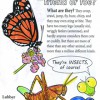 Not just a coloring book, but an interactive learning experience! This educational handout is perfect for classroom use, homeschool, or just a rainy (or snowy, if you are not in Florida) day. This activity will help connect kids and adults with the amazing diversity of animals for which we have articles in the UF/IFAS Featured Creatures database. This coloring book can be printed front to back on a standard 8.5 by 11 inch sheet of paper. Once you have your paper and coloring tools in hand, learn more about these creatures and decide what colors to use by reading more about them and visiting the web links for each insect. This 4-page fact sheet was written by Jennifer L. Gillett-Kaufman, and published by the UF Department of Entomology and Nematology, February 2014.
Not just a coloring book, but an interactive learning experience! This educational handout is perfect for classroom use, homeschool, or just a rainy (or snowy, if you are not in Florida) day. This activity will help connect kids and adults with the amazing diversity of animals for which we have articles in the UF/IFAS Featured Creatures database. This coloring book can be printed front to back on a standard 8.5 by 11 inch sheet of paper. Once you have your paper and coloring tools in hand, learn more about these creatures and decide what colors to use by reading more about them and visiting the web links for each insect. This 4-page fact sheet was written by Jennifer L. Gillett-Kaufman, and published by the UF Department of Entomology and Nematology, February 2014.
http://edis.ifas.ufl.edu/in1030
Planning for Effective Instruction
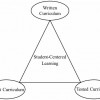 Deciding what students need to know through the development of declarative objectives, deciding what students need to able to do through the development of procedural objectives, considering how to evaluate student learning, and planning meaningful learning experiences will allow for effective instructional planning. Following these basic steps will allow educators to determine the specific goals of the lesson, the course, or the program in order to effectively prepare students. This 4-page fact sheet was written by Sarah E. Burleson and Andrew C. Thoron, and published by the UF Department of Agricultural Education and Communication, April 2014.
Deciding what students need to know through the development of declarative objectives, deciding what students need to able to do through the development of procedural objectives, considering how to evaluate student learning, and planning meaningful learning experiences will allow for effective instructional planning. Following these basic steps will allow educators to determine the specific goals of the lesson, the course, or the program in order to effectively prepare students. This 4-page fact sheet was written by Sarah E. Burleson and Andrew C. Thoron, and published by the UF Department of Agricultural Education and Communication, April 2014.
http://edis.ifas.ufl.edu/wc160
Maslow's Hierarchy of Needs and Its Relation to Learning and Achievement
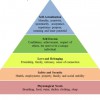 Learners in courses or training can be preoccupied. They worry about other courses, their home life, friends, extracurricular activities, physiological needs like food and sleep, and the list goes on. When learners are preoccupied with these concerns, learning and achievement are regularly put on the back burner. So how do we get our learners to focus on learning? Instructors can help learners satisfy needs, so the focus can be on content, learning, and achievement. This 3-page fact sheet was written by Sarah E. Burleson and Andrew C. Thoron, and published by the UF Department of Agricultural Education and Communication, April 2014.
Learners in courses or training can be preoccupied. They worry about other courses, their home life, friends, extracurricular activities, physiological needs like food and sleep, and the list goes on. When learners are preoccupied with these concerns, learning and achievement are regularly put on the back burner. So how do we get our learners to focus on learning? Instructors can help learners satisfy needs, so the focus can be on content, learning, and achievement. This 3-page fact sheet was written by Sarah E. Burleson and Andrew C. Thoron, and published by the UF Department of Agricultural Education and Communication, April 2014.
http://edis.ifas.ufl.edu/wc159
Using Social Norms to Increase Behavior Change in Sustainable Landscaping
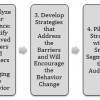 When Extension agents work to encourage behavioral changes in their community through educational programming, they may already be using some elements of social marketing. Extension educators can use an understanding of their clients’ reservations and inclinations toward a behavior, or their benefits and barriers, to develop strategies that encourage behavior change. Common strategies include prompts and reminders, incentives, and changing social norms. These strategies may be piloted on a small scale, modified if necessary, and then implemented on a large scale and further evaluated. This publication’s purpose is to describe the use of social norms as a social marketing strategy and make recommendations for applying social norms as a tool in Extension programming. This 5-page fact sheet was written by Laura Sanagorski and Paul Monaghan , and published by the UF Department of Agricultural Education and Communication, February 2014.
When Extension agents work to encourage behavioral changes in their community through educational programming, they may already be using some elements of social marketing. Extension educators can use an understanding of their clients’ reservations and inclinations toward a behavior, or their benefits and barriers, to develop strategies that encourage behavior change. Common strategies include prompts and reminders, incentives, and changing social norms. These strategies may be piloted on a small scale, modified if necessary, and then implemented on a large scale and further evaluated. This publication’s purpose is to describe the use of social norms as a social marketing strategy and make recommendations for applying social norms as a tool in Extension programming. This 5-page fact sheet was written by Laura Sanagorski and Paul Monaghan , and published by the UF Department of Agricultural Education and Communication, February 2014.
http://edis.ifas.ufl.edu/wc158
Florida Master Beekeeper Program Requirements
 The Master Beekeeper Program (MBP) is a five-year (minimum) beekeeper training and certification program provided by the University of Florida. One must already be a beekeeper to enter the program. This 22-page fact sheet was written by James Ellis, Jerry Hayes, Catherine Zettel Nalen, William H. Kern, Ray Zerba, Brad Burbaugh, and Jeanette Klopchin, and published by the UF Department of Entomology and Nematology, October 2013.
The Master Beekeeper Program (MBP) is a five-year (minimum) beekeeper training and certification program provided by the University of Florida. One must already be a beekeeper to enter the program. This 22-page fact sheet was written by James Ellis, Jerry Hayes, Catherine Zettel Nalen, William H. Kern, Ray Zerba, Brad Burbaugh, and Jeanette Klopchin, and published by the UF Department of Entomology and Nematology, October 2013.
http://edis.ifas.ufl.edu/in847
Inclusion of Diverse Learners in the Educational System
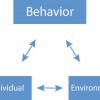 Every student in the United States has the right to an education. But not every student is ready, prepared, or willing to learn. Teachers trying to fully engage students in the learning environment can find it difficult when working with students from diverse backgrounds. Forms of diversity such as socioeconomic status, ethnicity/race, learning style, cognitive ability, gender, and ability to process and store knowledge can cause an “achievement gap” between students. This 4-page fact sheet highlights effective educational strategies for engaging students in the learning environment and assisting in closing achievement gaps. Written by Eric D. Rubenstein and Andrew C. Thoron, and published by the UF Department of Agricultural Education and Communication, July 2013.
Every student in the United States has the right to an education. But not every student is ready, prepared, or willing to learn. Teachers trying to fully engage students in the learning environment can find it difficult when working with students from diverse backgrounds. Forms of diversity such as socioeconomic status, ethnicity/race, learning style, cognitive ability, gender, and ability to process and store knowledge can cause an “achievement gap” between students. This 4-page fact sheet highlights effective educational strategies for engaging students in the learning environment and assisting in closing achievement gaps. Written by Eric D. Rubenstein and Andrew C. Thoron, and published by the UF Department of Agricultural Education and Communication, July 2013.
http://edis.ifas.ufl.edu/wc150
Parliamentary Procedure: Previous Question (WC138)
 The motion Previous Question is used to immediately close debate and to prevent the making of all subsidiary motions, except for the motion to Lay on the Table. Ordering the Previous Question does not prevent the making of any privileged or incidental motions, has no effect on the last question considered by the assembly, and is not allowed in committees. This 2-page fact sheet was written by Agricultural Education and Communication, and published by the UF Department of James E. Dyer, January 2013.
The motion Previous Question is used to immediately close debate and to prevent the making of all subsidiary motions, except for the motion to Lay on the Table. Ordering the Previous Question does not prevent the making of any privileged or incidental motions, has no effect on the last question considered by the assembly, and is not allowed in committees. This 2-page fact sheet was written by Agricultural Education and Communication, and published by the UF Department of James E. Dyer, January 2013.
http://edis.ifas.ufl.edu/wc138
Parliamentary Procedure: Lay on the Table (WC137)
 The motion to Lay on the Table is used to temporarily delay action on a pending question while something else of immediate urgency needs consideration, or when another item of business needs to be addressed before consideration of the pending question. This 2-page fact sheet was written by Agricultural Education and Communication, and published by the UF Department of James E. Dyer, January 2013.
The motion to Lay on the Table is used to temporarily delay action on a pending question while something else of immediate urgency needs consideration, or when another item of business needs to be addressed before consideration of the pending question. This 2-page fact sheet was written by Agricultural Education and Communication, and published by the UF Department of James E. Dyer, January 2013.
http://edis.ifas.ufl.edu/wc137
Parliamentary Procedure: Preparing Minutes of a Meeting (WC136)
 An official copy of the minutes of a meeting should be kept in a manner that is accessible to the membership, yet preserves their integrity as a historical record of the organization. This 4-page fact sheet was written by Agricultural Education and Communication, and published by the UF Department of James E. Dyer, January 2013.
An official copy of the minutes of a meeting should be kept in a manner that is accessible to the membership, yet preserves their integrity as a historical record of the organization. This 4-page fact sheet was written by Agricultural Education and Communication, and published by the UF Department of James E. Dyer, January 2013.
http://edis.ifas.ufl.edu/wc136
4-H School Enrichment: A Guide for 4-H Faculty and Staff (4H324)
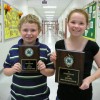 A partnership with the schools extends the 4‑H program to more youth through a unique delivery mode. Since School Enrichment may be a new experience for some Extension agents, this 8-page guide presents some strategies for developing a partnership with the schools and for programming. Written by Tracy A. Tesdall and published by the 4-H Youth Development Program, September 2012.
A partnership with the schools extends the 4‑H program to more youth through a unique delivery mode. Since School Enrichment may be a new experience for some Extension agents, this 8-page guide presents some strategies for developing a partnership with the schools and for programming. Written by Tracy A. Tesdall and published by the 4-H Youth Development Program, September 2012.
http://edis.ifas.ufl.edu/4h324
Ultrasound and Carcass Merit of Youth Market Cattle (AN279)
 Market cattle shown at county and state fairs and other youth shows across the United States are food animals. The endpoint value of food animals is primarily based on their carcass merit. Ideally, carcass merit should be assessed from actual carcasses. However, when carcass data cannot be collected, ultrasound evaluation of market cattle is an excellent method to accurately assess differences in fat thickness, ribeye area, and percentage of intramuscular fat within the ribeye. This 7-page fact sheet was written by Chad Carr, Dwain Johnson, and Mark Shuffitt, and published by the UF Department of Animal Science, June 2012.
Market cattle shown at county and state fairs and other youth shows across the United States are food animals. The endpoint value of food animals is primarily based on their carcass merit. Ideally, carcass merit should be assessed from actual carcasses. However, when carcass data cannot be collected, ultrasound evaluation of market cattle is an excellent method to accurately assess differences in fat thickness, ribeye area, and percentage of intramuscular fat within the ribeye. This 7-page fact sheet was written by Chad Carr, Dwain Johnson, and Mark Shuffitt, and published by the UF Department of Animal Science, June 2012.
http://edis.ifas.ufl.edu/an279
Starting and Maintaining 4-H Clubs (4HGCL00/4H281)
 This 16-page guide, intended for 4-H staff and volunteers, provides an overview to the types of clubs, the criteria and forms for chartering a new club, and for maintaining club status annually. It also outlines the fiscal responsibilities of club management and the standards for recognition. Written by J. Jordan, B. Terry, D. Pracht, J. Butterfield, and A. Cletzer, and published by the UF Department of 4-H Youth Development, March 2012.
This 16-page guide, intended for 4-H staff and volunteers, provides an overview to the types of clubs, the criteria and forms for chartering a new club, and for maintaining club status annually. It also outlines the fiscal responsibilities of club management and the standards for recognition. Written by J. Jordan, B. Terry, D. Pracht, J. Butterfield, and A. Cletzer, and published by the UF Department of 4-H Youth Development, March 2012.
http://edis.ifas.ufl.edu/4h281
Selecting Pigs for Youth Swine Shows (4HSWG04/4H210)
 Are you interested in participating in a swine show? This 8-page fact sheet will help youth exhibitors determine how and where to purchase a project pig and provide information on what the student should look for when purchasing the pig in order to do well. Published by the UF Department of 4-H Youth Development, April 2012.
Are you interested in participating in a swine show? This 8-page fact sheet will help youth exhibitors determine how and where to purchase a project pig and provide information on what the student should look for when purchasing the pig in order to do well. Published by the UF Department of 4-H Youth Development, April 2012.
http://edis.ifas.ufl.edu/4h210
¿Qué te está picando? (ENY2015S/IN927)
 Pulgas, piojos, chinches, o garrapatas? Ponle atención a tu insecto para que sepas lo que es. This poster was written by E. E. Harlow, C. A. McNeill, R. W. Baldwin, R. M. Pereira, P. G. Koehler, and J. C. Medley, and published by the UF Department of Entomology and Nematology, April 2012.
Pulgas, piojos, chinches, o garrapatas? Ponle atención a tu insecto para que sepas lo que es. This poster was written by E. E. Harlow, C. A. McNeill, R. W. Baldwin, R. M. Pereira, P. G. Koehler, and J. C. Medley, and published by the UF Department of Entomology and Nematology, April 2012.
http://edis.ifas.ufl.edu/in927